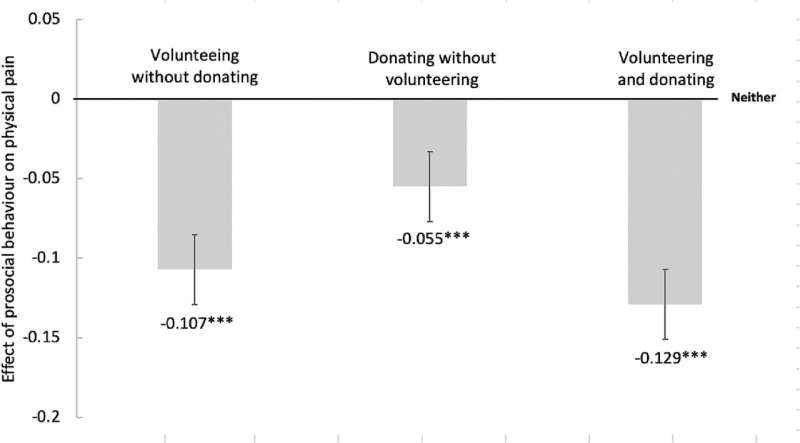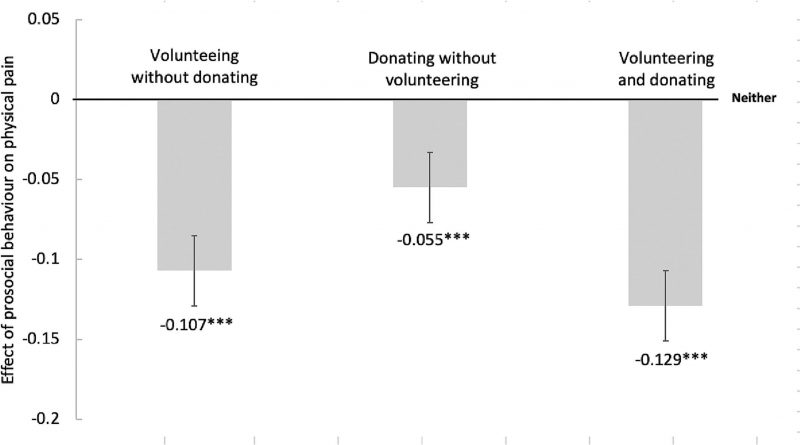Volunteering or donating to charity could help ease your physical pain, study suggests

A new, first-of-its-kind study suggests that volunteering with any organization, or donating money to charity, reduces the effects of physical pain on the ability of people to work, with volunteering having a larger effect than donating to charity.
The study from City, University of London and Harvard University also suggests that the more money donated to charity, the more physical pain was eased. It did not find a similar dose-dependent effect for the number of hours volunteered with an organization. However, the study did suggest that the magnitude of pain easing from volunteering was more than ten times the effect that each additional year of age of a participant had on increasing pain interference in their work.
While both volunteering and donating to charity was associated with a larger reduction in pain interference than volunteering alone, the difference in the results was not statistically significant.
The authors argue that the positive emotions that have previously been linked with engaging in prosocial behavior can help explain the current findings. In particular, volunteering has been found to be strongly associated with social connection which is a key predictor of well-being, including in relation to physical pain.
While prosocial behaviors, such as volunteering or donating to charity, have long been linked to benefits to one’s mental and physical health, until now, no study had investigated whether such behaviors were directly linked to reductions in physical pain.
In the study, the researchers performed analyses of responses to the United Kingdom Household Longitudinal Survey (UKHLS) between the years 2011 and 2020. The UKHLS is ongoing and is administered to participants annually, face-to-face. It was designed to be representative of the UK population as respondents represent all regions of the UK, ages, as well as educational and socioeconomic sectors.
In the main analysis, the responses of approximately 35,000 participants were used, responding to questions of whether they volunteered or not, donated to charity or not, and which were compared to their responses to whether physical pain interfered with their normal work (be it outside the home or housework) provided on a five-point scale of 0 (not at all) to 5 (extremely).
The average (mean) age of participants ranged from 49 to 48 years old across donating/volunteering groups, to 42 to 46 years old in the non donating/volunteering groups, with about 45 percent of the respondents being men.
Further analyses found that, overall, respondents who did versus did not donate money to charity reported a slower rise in pain over time, although this effect was not found for those who volunteered.
While the authors cannot fully rule out concerns about reverse causality playing a part in the findings, whereby people experiencing more pain may not engage in prosocial behaviors, they argue that the longitudinal study design, and other factors help counteract these concerns.
Physical pain is one of the main reasons people visit the accident and emergency room in the UK. Approximately nine million people in the UK live with chronic pain and musculoskeletal pain alone accounts for 30 percent of the country’s medical consultations.
Physical pain is known to adversely affect a person’s quality of life, including their mental health, productivity at work, and their experience of their family and workplace. Understanding factors that help to reduce pain is necessary for the design of the public health policies needed to address the issue.
Lead author of the study, Dr. Lucía Macchia, Lecturer in Psychology at City, University of London, said, “This research contributes to the new and fast-growing literature that studies pain from a socioeconomic, psychosocial, and behavioral perspective. The work provides useful information for the design and evaluation of public health policies by uncovering how engaging in prosocial behavior, which can create powerful positive emotions and reduce negative mood like stress, can positively affect one’s pain.”
The study is published in the Journal of Psychosomatic Research.
More information:
Lucía Macchia et al, Prosocial behaviour helps to ease physical pain: Longitudinal evidence from Britain, Journal of Psychosomatic Research (2023). DOI: 10.1016/j.jpsychores.2023.111325
Journal information:
Journal of Psychosomatic Research
Source: Read Full Article
